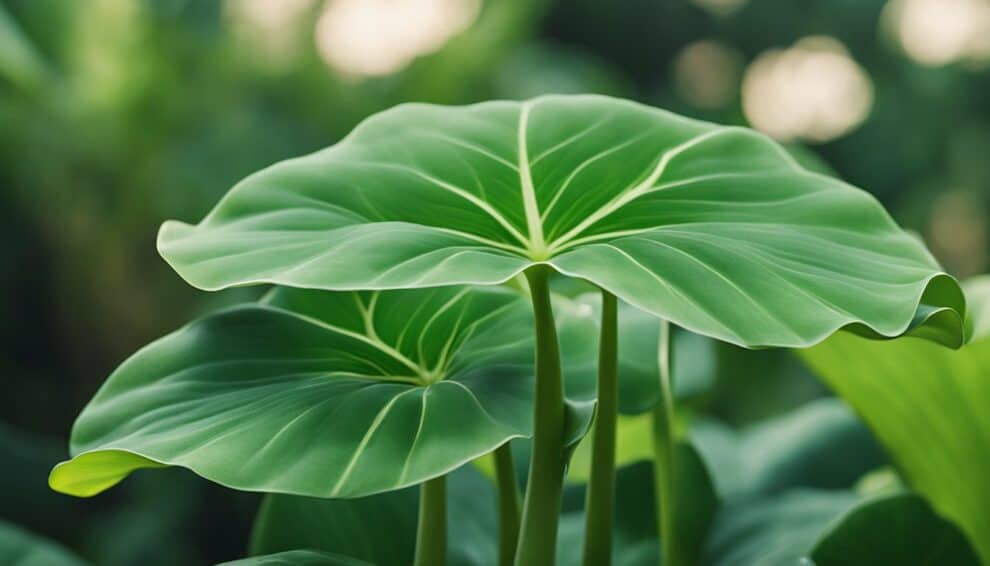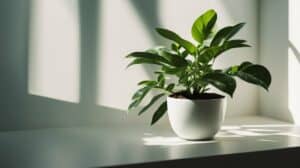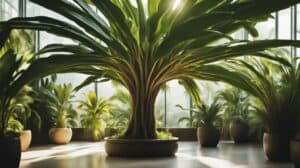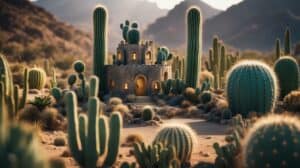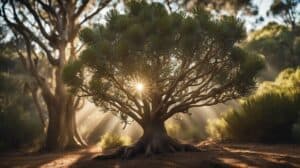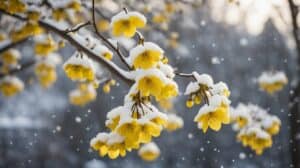Bergenia Crassifolia, commonly known as the Elephant’s Ears Plant, is a hardy and versatile perennial that can be found in many gardens and landscapes.
This plant is native to the Himalayas and is known for its large, glossy, and thick leaves that resemble the ears of an elephant.
The plant produces clusters of pink or white flowers in the spring, making it an attractive addition to any garden.

The Elephant’s Ears Plant is a low-maintenance plant that is easy to grow and care for.
It can thrive in a variety of soil types and is tolerant of both sun and shade.
This makes it an ideal plant for gardeners who want an attractive and reliable plant that requires minimal attention.
Additionally, the plant is resistant to pests and diseases, making it a great choice for gardeners who want to avoid using harsh chemicals in their gardens.
In this article, we will explore the many benefits of growing Bergenia Crassifolia, including its hardiness, versatility, and low-maintenance requirements.
We will also provide tips for growing and caring for this plant, as well as ideas for incorporating it into your garden or landscape design.
Whether you are an experienced gardener or a novice, the Elephant’s Ears Plant is a great choice for adding beauty and interest to your outdoor space.
Origins and Habitat

Bergenia Crassifolia is a herbaceous plant that belongs to the Saxifragaceae family, which is native to Central Asia.
It is commonly known as Elephant’s Ears due to its large, thick, and fleshy leaves that resemble the ears of an elephant.
Native Regions
The plant is native to the mountainous regions of Central Asia, including Afghanistan, Kazakhstan, Kyrgyzstan, Pakistan, Tajikistan, and Uzbekistan.
It is commonly found growing in the rocky and gravelly areas of the mountains at an altitude of 1200-4000 meters above sea level.
Preferred Climate and Soil
Bergenia Crassifolia prefers a cool and dry climate with a temperature range of 10-20°C.
It can tolerate extreme cold temperatures and is known to survive in temperatures as low as -40°C.
The plant prefers well-drained soil that is rich in organic matter and has a pH range of 6.0-7.5.
The plant is commonly used as an ornamental plant due to its attractive foliage and ability to grow in a wide range of climatic conditions.
It is also used in traditional medicine for its anti-inflammatory, anti-bacterial, and anti-cancer properties.
In conclusion, Bergenia Crassifolia is a hardy plant that is native to Central Asia and can grow in a wide range of climatic conditions.
Its unique foliage and medicinal properties make it a popular choice for gardeners and herbalists alike.
Plant Characteristics
Physical Description
Bergenia Crassifolia, commonly known as Elephant’s Ears, is a perennial plant that belongs to the Saxifragaceae family.
The plant has large, leathery, and glossy leaves that are shaped like elephant ears, which is how it gets its common name.
The leaves are typically green, but they can also be bronze or reddish in color.
The plant produces clusters of pink, red, or white flowers that bloom in the spring.
The leaves of Bergenia Crassifolia can grow up to 12 inches long and 6 inches wide. They are thick and fleshy, which helps the plant to retain moisture.
The leaves are arranged in a rosette pattern at the base of the plant and are attached to a short stem.
Growth Habit
Bergenia Crassifolia is a low-growing plant that typically reaches a height of 12 to 18 inches. It has a clumping growth habit and spreads slowly over time.
The plant prefers partial shade to full sun and well-draining soil. It is hardy in USDA zones 3 to 8.
Bergenia Crassifolia is a low-maintenance plant that is easy to grow. It requires little water and fertilizer and is relatively pest and disease-free.
The plant is commonly used in garden borders, rock gardens, and as ground cover. It also makes an excellent container plant.
Cultivation and Care

Planting Guidelines
Bergenia Crassifolia, commonly known as Elephant’s Ears, is a hardy plant that can thrive in a variety of growing conditions.
When planting Bergenia Crassifolia, it is important to choose a location that receives partial to full shade.
The soil should be well-draining and rich in organic matter.
To plant Bergenia Crassifolia, dig a hole that is twice the size of the plant’s root ball.
Place the plant in the hole and backfill with soil, making sure to tamp down the soil around the plant.
Water thoroughly after planting and continue to water regularly until the plant is established.
Maintenance Tips
Bergenia Crassifolia is a low-maintenance plant that requires minimal care. However, there are a few things to keep in mind to ensure the plant thrives.
Watering: Bergenia Crassifolia prefers moist soil, so it is important to water regularly, especially during dry spells.
However, be careful not to overwater, as this can lead to root rot.
Fertilizing: Bergenia Crassifolia does not require frequent fertilization.
However, a light application of balanced fertilizer in the spring can help promote healthy growth.
Pruning: Bergenia Crassifolia does not require pruning, but removing dead or damaged leaves can help keep the plant looking tidy.
Pests and Diseases: Bergenia Crassifolia is relatively pest and disease-resistant.
However, keep an eye out for slugs and snails, which can damage the leaves. If necessary, use a slug and snail bait to control these pests.
Overall, Bergenia Crassifolia is a beautiful and easy-to-care-for plant that can add interest to any garden.
With minimal maintenance and the right growing conditions, this plant can thrive for years to come.
Uses and Benefits

Garden Design
Bergenia Crassifolia, also known as Elephant’s Ears Plant, is a popular ornamental plant that can be used in a variety of garden designs.
Its large, glossy leaves add texture and interest to garden beds, while its pink or purple flowers provide a pop of color in the spring.
The plant is also drought-tolerant and can withstand cold temperatures, making it a great choice for gardens in cooler climates.
Medicinal Applications
In addition to its aesthetic appeal, Bergenia Crassifolia has a number of medicinal applications.
The plant contains compounds that have been shown to have anti-inflammatory and anti-bacterial properties, making it useful in the treatment of a variety of ailments.
It has been used to treat respiratory infections, digestive issues, and skin conditions, among other things.
Some studies have also suggested that Bergenia Crassifolia may have anti-cancer properties, although more research is needed to confirm these findings.
Overall, the plant’s medicinal properties make it a valuable addition to any herbal medicine cabinet.
In conclusion, Bergenia Crassifolia is a versatile plant with many uses and benefits.
Whether you’re looking to add some visual interest to your garden or seeking a natural remedy for a health issue, this plant is definitely worth considering.
Frequently Asked Questions

How do you care for Bergenia crassifolia in different seasons?
Bergenia crassifolia is a hardy plant that can thrive in different seasons. In spring, it requires regular watering to promote new growth and flowering.
During summer, it needs to be watered regularly and protected from direct sunlight. In fall, it needs to be fertilized to prepare for the winter.
In winter, it needs to be protected from frost and snow.
What does the Bergenia crassifolia symbolize in various cultures?
Bergenia crassifolia is known by different names in various cultures.
In China, it is called “Pigs’ Ears” and is believed to bring good luck.
In Russia, it is called “Heartleaf” and is associated with love and friendship.
In Europe, it is called “Elephant’s Ears” and is said to represent strength and endurance.
What are the ideal conditions for planting Bergenias in the garden?
Bergenias prefer well-drained soil that is rich in organic matter. They can tolerate partial shade or full sun, but they grow best in partial shade.
They require regular watering, especially during the first year after planting. They can be planted in spring or fall.
How quickly does bergenia crassifolia grow and spread?
Bergenia crassifolia grows at a moderate pace and can reach a height of 1 to 2 feet. It can spread up to 2 feet wide.
It can take 2 to 3 years for the plant to reach its full size.
Are elephant ear plants perennial and will they return after winter?
Yes, elephant ear plants are perennial and will return after winter. They can survive temperatures as low as -20°F.
However, they may require some protection during the winter, such as mulching or covering with a frost cloth.
How much sunlight do elephant ears need to thrive?
Elephant ears can tolerate partial shade or full sun, but they grow best in partial shade. They require at least 4 to 6 hours of sunlight per day to thrive.
Too much direct sunlight can cause the leaves to scorch.






